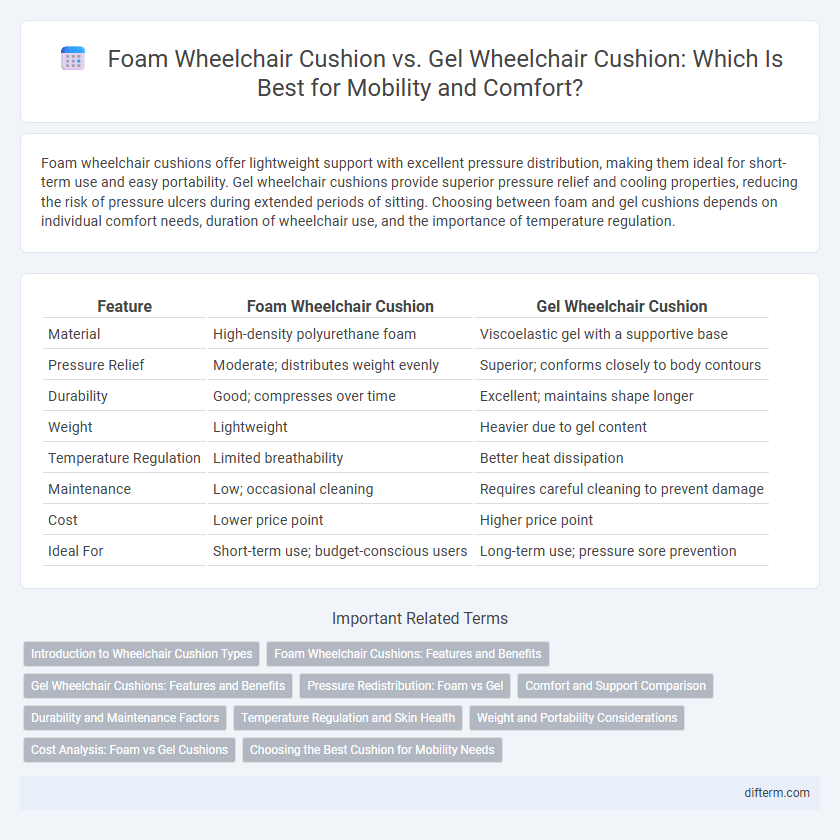Foam wheelchair cushions offer lightweight support with excellent pressure distribution, making them ideal for short-term use and easy portability. Gel wheelchair cushions provide superior pressure relief and cooling properties, reducing the risk of pressure ulcers during extended periods of sitting. Choosing between foam and gel cushions depends on individual comfort needs, duration of wheelchair use, and the importance of temperature regulation.
Table of Comparison
| Feature | Foam Wheelchair Cushion | Gel Wheelchair Cushion |
|---|---|---|
| Material | High-density polyurethane foam | Viscoelastic gel with a supportive base |
| Pressure Relief | Moderate; distributes weight evenly | Superior; conforms closely to body contours |
| Durability | Good; compresses over time | Excellent; maintains shape longer |
| Weight | Lightweight | Heavier due to gel content |
| Temperature Regulation | Limited breathability | Better heat dissipation |
| Maintenance | Low; occasional cleaning | Requires careful cleaning to prevent damage |
| Cost | Lower price point | Higher price point |
| Ideal For | Short-term use; budget-conscious users | Long-term use; pressure sore prevention |
Introduction to Wheelchair Cushion Types
Foam wheelchair cushions provide lightweight support with varying density levels to enhance pressure distribution and comfort during extended use. Gel wheelchair cushions feature a gel-filled design that offers superior pressure relief by conforming to the body's shape and reducing the risk of pressure sores. Both types are essential in mobility aids, tailored to individual needs based on factors such as weight, posture, and skin sensitivity.
Foam Wheelchair Cushions: Features and Benefits
Foam wheelchair cushions offer lightweight durability with excellent pressure distribution, making them ideal for users seeking reliable support and comfort during extended mobility. High-density foam varieties provide superior shock absorption and maintain their shape over time, reducing the risk of skin sores and improving posture. These cushions are also breathable and cost-effective, enhancing overall wheelchair usability without compromising performance.
Gel Wheelchair Cushions: Features and Benefits
Gel wheelchair cushions offer superior pressure distribution and enhanced comfort by conforming to the user's body shape, reducing the risk of pressure sores and promoting better blood circulation. These cushions maintain consistent support without flattening over time, making them ideal for long-term use and individuals with sensitive skin. Their temperature-regulating properties provide a cooling effect, improving overall seating comfort during extended periods of mobility.
Pressure Redistribution: Foam vs Gel
Foam wheelchair cushions offer effective pressure redistribution through their ability to conform to the body's shape, providing consistent support and shock absorption, which helps prevent pressure sores. Gel wheelchair cushions excel in evenly distributing pressure by molding around bony prominences, reducing peak pressure points and enhancing comfort during prolonged sitting. Comparing both, gel cushions typically provide superior pressure redistribution due to their dynamic adjustment to movement and weight shifts, while foam cushions offer reliable, lightweight support with less maintenance.
Comfort and Support Comparison
Foam wheelchair cushions offer lightweight support and excellent pressure distribution, making them ideal for users seeking a balance of comfort and affordability. Gel wheelchair cushions provide superior pressure relief by conforming closely to body contours, reducing the risk of pressure sores for long-term use. Comfort effectiveness depends on individual needs, with foam cushions excelling in breathability and gel cushions in maintaining cushioning under prolonged pressure.
Durability and Maintenance Factors
Foam wheelchair cushions generally offer moderate durability but tend to compress and lose shape over time, requiring more frequent replacement compared to gel cushions. Gel wheelchair cushions provide superior durability due to their resistance to deformation, maintaining support and comfort for extended periods with minimal maintenance. Maintenance for foam cushions involves regular cleaning and occasional re-fluffing, whereas gel cushions need less upkeep but require vigilance against punctures or leaks to preserve their longevity.
Temperature Regulation and Skin Health
Foam wheelchair cushions provide moderate temperature regulation by allowing some air circulation, which helps reduce moisture buildup and prevents skin maceration. Gel wheelchair cushions excel in temperature regulation due to their material's ability to disperse heat evenly, minimizing pressure points and reducing the risk of skin breakdown. Both cushion types support skin health by alleviating pressure, but gel cushions offer superior cooling effects essential for users prone to excessive sweating and pressure ulcers.
Weight and Portability Considerations
Foam wheelchair cushions are significantly lighter than gel cushions, enhancing overall portability and ease of transport for users who frequently travel or transfer their wheelchair. Gel cushions tend to be heavier due to the dense gel material, which can add strain during lifting or carrying but offer superior pressure distribution. Weight considerations directly impact user mobility, making foam cushions preferable for those prioritizing reduced load without compromising basic support.
Cost Analysis: Foam vs Gel Cushions
Foam wheelchair cushions generally cost less upfront, with prices ranging from $30 to $100, making them an economical choice for basic pressure relief. Gel cushions, priced between $80 and $250, offer enhanced durability and pressure distribution, which can reduce long-term healthcare expenses related to pressure sores. Evaluating total cost of ownership, gel cushions may provide better value by minimizing medical interventions and replacement frequency compared to foam cushions.
Choosing the Best Cushion for Mobility Needs
Foam wheelchair cushions offer lightweight support and excellent pressure distribution, ideal for users seeking durability and ease of maintenance in daily mobility. Gel wheelchair cushions provide superior contouring and cooling properties, reducing pressure points and enhancing comfort for extended use. Selecting the best cushion depends on individual needs such as weight distribution, skin sensitivity, and duration of seating to optimize mobility and prevent pressure sores.
foam wheelchair cushion vs gel wheelchair cushion Infographic

 difterm.com
difterm.com